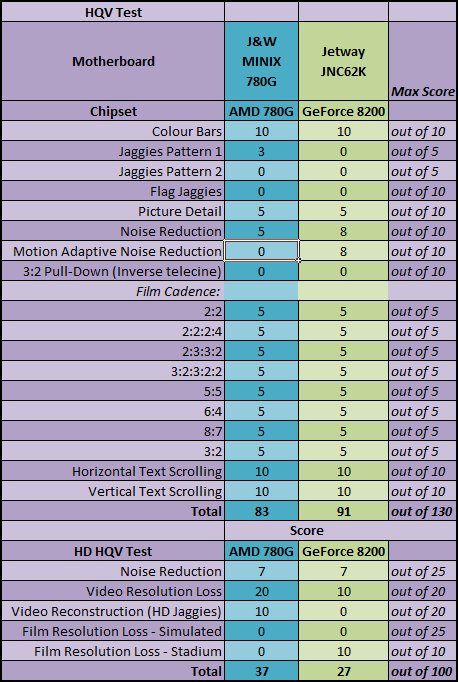HQV and HDHQV
Silicon Optix, makers of HQV and HD HQV, provides an industry standard benchmark for looking at video quality by providing tests the cover all areas of video processing playback: (motion adaptive) de-interlacing, noise reduction, 3:2 Pull-down detection (Inverse telecine), Film Cadence and Film Resolution manipulation.The tests are scored out of 130 and 100 for the HQV and HD HQV tests respectively, where a score of 130 and 100 in each case is considered "perfect."
We set the output at 1080p to test the video processing of the chipset, as opposed to the display. While we left the "performance settings" on auto, we did adjust the de-interlacing settings to find the best solution available from the drivers.

HQV
For pattern one, the jaggies were only visible in the yellow and green areas, but not the red furthest out - this was better than the GeForce 8200 which were clearly visible everywhere, but in test pattern two, the three lines had no visible effective deinterlacing like the GeForce.The picture detail test on the AMD 780G exhibited the same level of quality as the GeForce 8200; both gave very good quality video but lacked any extra sharpness.
On the noise reduction and motion adaptive noise reduction tests, there was no option in the PowerDVD software and the option is greyed out in the AMD software so while no controllable noise reduction was taking place, there seems to be a little taking place. Under the "application default" setting there is no noise reduction and it's clearly visible, and then by increasing the slider to 100 percent the noise reduction was absolutely perfect, however it also caused the image to shake noticeably slightly.
In the motion adaptive noise reduction there is clearly more noise in the sky, so according to HQV the test fails, but the image remains quite sharp and doesn't streak. Despite enabling inverse telecine detection in the ATI control panel, no actual effect was observed in the video playback.
The overall result is ten points lower than what we observed with the Gigabyte 780G motherboard, but it's important to stress that making direct comparisons between the two isn't easy, because of the different testing dates (as this test is subjective) and older versus newer driver software. For instance AMD seems to have removed the option for any advanced deinterlacing options other than the standard "Bob" in its Catalyst Control Center when it used to feature extra levels like Motion Adaptive deinterlacing, and its advanced features like Noise Reduction were always greyed out to manual control.
HDHQV
Like the GeForce 8200 motherboard, the image quality on the J&W MINIX 780G is still good, but the noise is still clearly noticeable. The "de-noise" option in the video quality options in the Catalyst Control Center was greyed out so unlike the GeForce 8200 there was no adjusting this option.The motion adaptive deinterlacing is also considerably better then the GeForce 8200 as well, and just like the Gigabyte 780G microATX board two of the bars are deinterlaced properly but the third has clear jaggies.
In the video resolution loss the quality was perfect for the AMD 780G, certainly better than the GeForce 8200, however with the latest drivers we couldn't get rid of the Moire pattern in the Stadium section and there was clear flickering of the white and black boxes with and without deinterlacing enabled in the film resolution loss tests. The overall result is marginally better, but the most important bit for us to consider in our opinion is the deinsterlacing reduction which the AMD 780G is clearly better at.

MSI MPG Velox 100R Chassis Review
October 14 2021 | 15:04










Want to comment? Please log in.